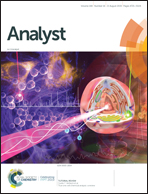Simultaneous detection of carcinoembryonic antigen and neuron-specific enolase in human serum based on time-resolved chemiluminescence immunoassay†
Abstract
In the clinical diagnosis of tumor, the immunological detection of single tumor markers may lead to errors and missed inspection. Therefore, it is necessary to establish an accurate and effective method for the simultaneous detection of multiple tumor markers. Thus, we developed a time-resolved chemiluminescence immunoassay (TRCLIA) to simultaneously detect carcinoembryonic antigen (CEA) and neuron-specific enolase (NSE) in human serum. Horseradish peroxidase (HRP) and alkaline phosphatase (ALP) were used as the detection probes to label the monoclonal antibodies of CEA and NSE by strain-promoted azide–alkyne cycloaddition (SPAAC), respectively. Based on a sandwich immunoassay, the targets in the samples were captured by antibodies immobilized on the surface of carboxylate-modified polystyrene microspheres (CPSMS) and sandwiched by other antibodies labeled with HRP and ALP. Since HRP and ALP had different dynamic characteristics, the CEA and NSE signals were recorded at 0.5 s and 20 min, respectively, and cross-interference could be avoided effectively. The whole signal detection processes could be completed in 20 min. The linear ranges of CEA and NSE were 0.1–64 ng mL−1 and 0.05–64 ng mL−1 and the limits of detection were 0.085 ng mL−1 and 0.044 ng mL−1 (S/N = 2), respectively. Also, 45 human serum samples obtained from patients having lung disease were tested by TRCLIA and commercial chemiluminescence enzyme-linked immunoassay (CLEIA) kits with good correlation. The correlation coefficients of CEA and NSE were 0.985 and 0.970, respectively. The results demonstrated a novel, effective, reliable and convenient TRCLIA method for the clinical diagnosis of CEA and NSE. The TRCLIA method has the potential to be an effective clinical tool for the early screening of lung cancer and can be applied in clinical diagnosis.



 Please wait while we load your content...
Please wait while we load your content...